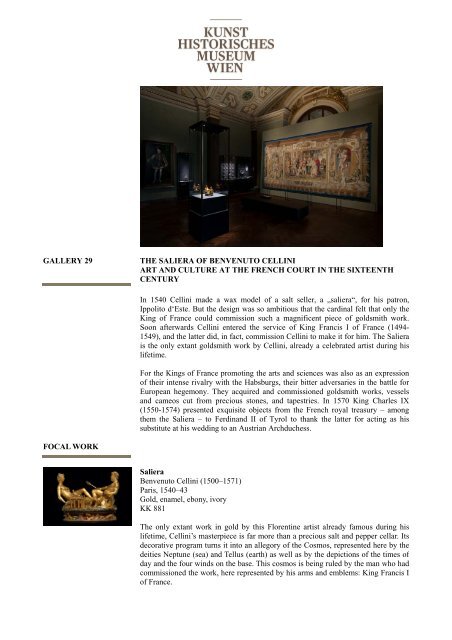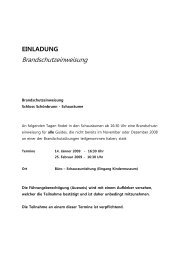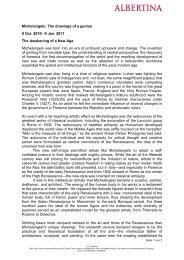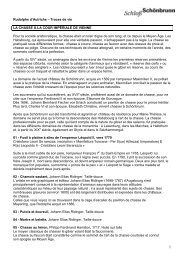kunstkammer vienna the cradle of the museum - Freizeitbetriebe ...
kunstkammer vienna the cradle of the museum - Freizeitbetriebe ...
kunstkammer vienna the cradle of the museum - Freizeitbetriebe ...
Create successful ePaper yourself
Turn your PDF publications into a flip-book with our unique Google optimized e-Paper software.
GALLERY 29 THE SALIERA OF BENVENUTO CELLINI<br />
ART AND CULTURE AT THE FRENCH COURT IN THE SIXTEENTH<br />
CENTURY<br />
FOCAL WORK<br />
In 1540 Cellini made a wax model <strong>of</strong> a salt seller, a „saliera“, for his patron,<br />
Ippolito d‘Este. But <strong>the</strong> design was so ambitious that <strong>the</strong> cardinal felt that only <strong>the</strong><br />
King <strong>of</strong> France could commission such a magnificent piece <strong>of</strong> goldsmith work.<br />
Soon afterwards Cellini entered <strong>the</strong> service <strong>of</strong> King Francis I <strong>of</strong> France (1494-<br />
1549), and <strong>the</strong> latter did, in fact, commission Cellini to make it for him. The Saliera<br />
is <strong>the</strong> only extant goldsmith work by Cellini, already a celebrated artist during his<br />
lifetime.<br />
For <strong>the</strong> Kings <strong>of</strong> France promoting <strong>the</strong> arts and sciences was also as an expression<br />
<strong>of</strong> <strong>the</strong>ir intense rivalry with <strong>the</strong> Habsburgs, <strong>the</strong>ir bitter adversaries in <strong>the</strong> battle for<br />
European hegemony. They acquired and commissioned goldsmith works, vessels<br />
and cameos cut from precious stones, and tapestries. In 1570 King Charles IX<br />
(1550-1574) presented exquisite objects from <strong>the</strong> French royal treasury – among<br />
<strong>the</strong>m <strong>the</strong> Saliera – to Ferdinand II <strong>of</strong> Tyrol to thank <strong>the</strong> latter for acting as his<br />
substitute at his wedding to an Austrian Archduchess.<br />
Saliera<br />
Benvenuto Cellini (1500–1571)<br />
Paris, 1540–43<br />
Gold, enamel, ebony, ivory<br />
KK 881<br />
The only extant work in gold by this Florentine artist already famous during his<br />
lifetime, Cellini’s masterpiece is far more than a precious salt and pepper cellar. Its<br />
decorative program turns it into an allegory <strong>of</strong> <strong>the</strong> Cosmos, represented here by <strong>the</strong><br />
deities Neptune (sea) and Tellus (earth) as well as by <strong>the</strong> depictions <strong>of</strong> <strong>the</strong> times <strong>of</strong><br />
day and <strong>the</strong> four winds on <strong>the</strong> base. This cosmos is being ruled by <strong>the</strong> man who had<br />
commissioned <strong>the</strong> work, here represented by his arms and emblems: King Francis I<br />
<strong>of</strong> France.

















